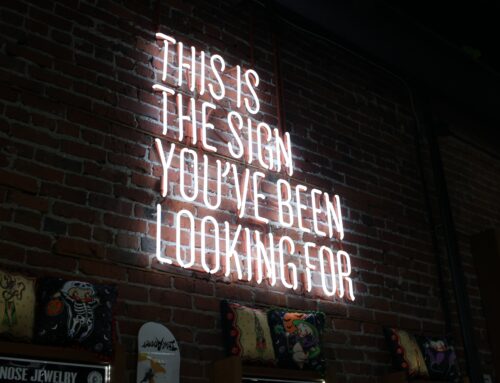Y ear-on-year, online retailers take increasingly larger bites of the global retail market. In 2021, e-commerce represented a 20% share of global retail sales, and it’s on course to account for almost a quarter by 2025. Items are starting to stack up in the online shopping cart.
There’s no denying that younger generations of retail customers have grown up with a more engaging and interactive customer experience. In fact, for digital natives, who know no different, they’re accustomed to convenient price comparisons alongside interactive and immersive retail experiences – as well as simplified shipping and returns.
So, how can retailers and other brick and mortar businesses maintain their appeal, ensure returning footfall in an increasing digital market? Digital signage can help bridge the gap between the clicks and the bricks.
A sign of the times
Many pre-digital retailers now offer their customers both an offline and online experience, and consumers have come to expect a more interactive service. That’s why it’s imperative for physical retailers to make the shopping experience more engaging in order to stay competitive, or risk falling behind.
If you run a small business which is less tech-orientated, or you’re not technically minded, upping brand engagement to appeal to tech-savvy consumers can feel overwhelming. Thankfully, digital signage offers a hassle-free way to connect with those customers without the need for extensive technical knowledge. In fact, any web-based application can be implemented into a digital sign.
The key is how you deploy digital signage to create event-driven interactions and memorable experiences that will encourage repeat customers.
Bringing versatility in-store
Digital signage offers versatility which cannot be matched by static displays. And the opportunities go way beyond the capabilities of the humble poster. Remember, your business is competing with the screen in your customer’s hand, so the experience you give them in-store is always going to be judged against that.
And if you already have a successful online presence, digital signage can help you bring the best of that good work in-store. When considering your digital signage strategy, it’s important to be aware of the possible purposes behind the deployment of your signs.
Functional
If you’ve visited a quick service restaurant (QSR) recently, you’ll be familiar with touchscreen ordering. With the user interface (UI) resembling that of an online food ordering app, these screens bring the smartphone experience to the store. With tempting images of food alongside clear menu pricing (which can be easily adjusted by the restaurant owner) these digital signs can also signpost the latest offers, and direct customers towards deals and new products.
Contextual
Particularly in retail chains or franchises, it can be difficult to differentiate one store from another. Sometimes the air of familiarity is the point. But sometimes it’s important to connect the retail space with the community it’s in. So digital signage sharing local information, upcoming events, or charities is a great way to add value for your customers and show that you care.
Navigational
In larger retails spaces such as mall or department stores, digital signage can be used to assist navigation. Strategically positioned screens could offer directions through the space, or even help people navigate from where they are to where they want to go by providing route maps or through other navigational systems such as what3words. Used in this way, digital signage presents exciting opportunities for more interactive and personalized wayfinding.
Educational
Providing educational information alongside product or promotional material is another way to add value to the customer experience. For example, digital signage could display information about the way a product is made, or factual information about its country of origin or for the climate conscious consumer, facts about its green credentials. It could also be used to engage children with quizzes or activities, whilst their parents shop.
Informational
The types of digital signage you install can also impact the way a customer will use it and therefore what information you choose to display. For example, a smaller, tablet-sized device is more discrete and gives a more personalized experience for the shopper. So if a customer is looking for colors, sizes, or even wants a virtual fitting, a large display is less ideal.
Digital signage is a great way to keep customers up to date with the latest information because it can be updated as frequently, or as infrequently, as required. The classic example is menu boards, but they can easily be used to provide the kind of product information – dimensions, care instructions, country of origin – that shoppers are used to getting online.
Recreational
It’s become a cultural cliché that when faced with a period of waiting or inactivity, the first thing people do is reach for their phones. And rather than let a captive audience’s minds wander elsewhere whilst they’re standing in line, waiting to be served, or otherwise inactive, serving up engaging and exciting content is an ideal way to keep their attention on your brand, and build a stronger connection.
Promotional
Of course, digital signage also helps to increase your advertising acreage, so there’s a clear opportunity to promote your latest deals or recent offers. Things start to get really clever when you introduce sensors which can trigger particular on-screen content to create more meaningful and personalized events for your customer. Perhaps, entering a particular department or picking up a certain item triggers screen content that adds value for the customer, such as offers or recommendations.
Encouraging sign-ups
The beauty of digital signage is that it uses techniques from digital marketing to bring things familiar from the online world into the physical world, whether that’s event-driven campaigns and tailored advertising or product information and price comparisons.
In essence, that in-store screen becomes the start of a customer-led sales funnel which grabs users’ attention before engaging them with relevant content, and delivering what they want, when they want it. From a marketing perspective, every time there’s an engagement, you have the potential to collect data to provide actionable insights.
In that sense, creating a more interactive customer experience can lead to opportunities to optimize your in-store messaging, and increase its impact – in much the same way as digital marketing.



